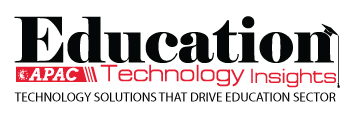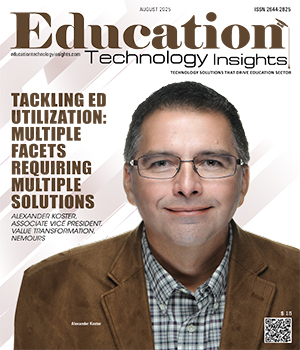THANK YOU FOR SUBSCRIBING
Be first to read the latest tech news, Industry Leader's Insights, and CIO interviews of medium and large enterprises exclusively from Education Technology Insights
Tech-Enabled, Human-Centered: Effective Student Support
Travis T. Apgar, Vice President for Student Affairs, Case Western Reserve University
 Travis T. Apgar, Vice President for Student Affairs, Case Western Reserve University
Travis T. Apgar, Vice President for Student Affairs, Case Western Reserve UniversityTravis T. Apgar is Vice President for Student Affairs at Case Western Reserve University and a national advocate for student well-being, belonging, and engagement in higher education.
The Role of Technology in Student Success
Technology now functions as the nervous system of higher education—continuously transmitting data, managing operations, and shaping the student journey. It permeates every layer of the college experience, from enrollment, advising, and registration to health, well-being, and community engagement. Through predictive analytics, artificial intelligence, and integrated data systems, institutions now have an unprecedented window into how students learn, connect, and flourish. Data-driven decision-making is more robust than ever.
These advances have significantly propelled the work of student engagement and success, simplifying processes that once consumed hours of staff and faculty time. Yet no matter how sophisticated or streamlined these systems become, they will never be adequate substitutes for the human connections and care our students need.
Using Technology to Enhance Human Connection
In fact, it should be a goal to invest in technology primarily to provide those in engagement and support roles with more time and better insight—helping them focus their energy for the most significant impact. When used intentionally, technology can enable staff to proactively identify students who need help, build timely interventions, and strengthen the overall student experience. The result is not only improved success metrics like retention and persistence, but also more meaningful relationships across campus.
“Technology should extend relationships, not replace them.”
Every semester, some students quietly drift toward disengagement—missing classes, delaying assignments, or withdrawing from campus life. Predictive analytics can now detect those patterns before they become crises, enabling proactive outreach and support. But data alerts are not an act of empathy. Technology can tell us who might be struggling and even help determine why, but it takes people to implement effective support measures. When systems handle the detection and coordination, advisors, faculty, and student affairs professionals can focus on what matters most—human connection. Technology should extend relationships, not replace them.
Fostering Belonging and Equity through Digital Tools
This emphasis on genuine human connection has never been more urgent. National data reveal alarming trends in student well-being. College counseling centers continue to report record demand, with students citing high levels of depression and anxiety. Nearly one in ten students has seriously considered suicide in the past year. Even among those who are not clinically depressed or anxious, many describe feeling lonely, disconnected, or lacking a sense of belonging and purpose. These realities demand responses rooted in care, community, and relationships—responses no algorithm can fully deliver.
Today’s students also expect experiences that are personalized, responsive, and easy to navigate. Digital engagement platforms can meet that expectation, linking academic interests, co-curricular involvement, and support services into one coherent picture of a student’s journey. Used well, these tools make large campuses feel smaller. They can connect a student passionate about health equity with a service opportunity, or introduce an aspiring engineer to a research mentor. When designed with care, technology helps students discover the people and programs that give them purpose and belonging. Still, no platform can replace a genuine conversation or a moment of recognition. The best tools create more opportunities for those moments to occur.
Technology also offers new ways to strengthen community and shared identity. Digital storytelling platforms, virtual engagement hubs, and campus apps allow students to celebrate achievements, share experiences, and sustain traditions beyond the physical campus. These spaces can help students see themselves reflected in the life of the institution—contributing their voices rather than merely observing from the sidelines. When implemented thoughtfully, digital community-building complements in-person connection and extends a sense of pride that endures long after graduation. But pride in one’s university ultimately grows from authentic human experience: the mentor who listens, the team that feels like family, the late-night conversation that changes perspective. Technology should highlight those moments, not attempt to replace them.
The most overlooked value of technology is the time it can return to people. Complex, disconnected administrative systems burden students—and the staff who help them—with unnecessary frustration. By integrating platforms and simplifying student-facing processes, institutions reduce friction for everyone. A student who can manage registration, billing, housing, and advising in one place is less likely to fall through the cracks. And when routine tasks are automated or simplified, staff and faculty regain the time to do what only humans can: mentor, advice, and care. Streamlining is not just about efficiency; it’s about equity. Simplified systems remove barriers that disproportionately affect first-generation and marginalized students. Designing for clarity and accessibility is an act of inclusion.
The goal is not a fully digital university—it is a university that uses digital tools to become more human. Technology should help us see students more clearly, to know them as individuals. It should make our work more efficient and more personal. When implemented with intention—grounded in equity, designed around the student experience, and centered on relationships—technology fulfills its most significant potential. It gives us the insight and time to focus on what matters most: connecting with students in meaningful ways.
The promise of technology in higher education is not that it can do our work for us. It can help us do the most critical work—listening, guiding, and ensuring every student feels known, supported, and inspired to succeed.
Read Also
Building an Understanding of AI in Learning Environments
Integrating SEL, Digital Citizenship, and AI Literacy in K–8 Schools
Preparing Students for More than their First Job
Moving Beyond Reaction to Proactive Student Engagement
Tech-Enabled, Human-Centered: Effective Student Support
Compassion That Shapes Student Success

I agree We use cookies on this website to enhance your user experience. By clicking any link on this page you are giving your consent for us to set cookies. More info

However, if you would like to share the information in this article, you may use the link below:
www.educationtechnologyinsightsapac.com/cxoinsights/travis-t-apgar-nid-3549.html






















